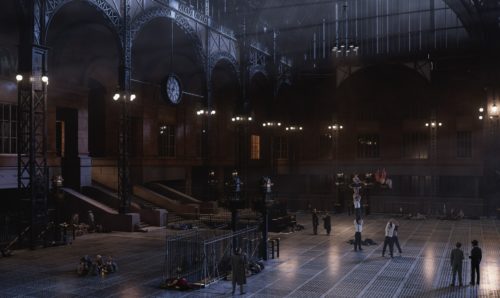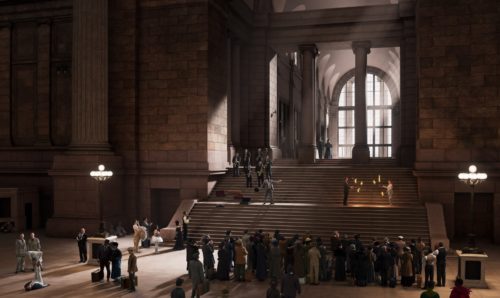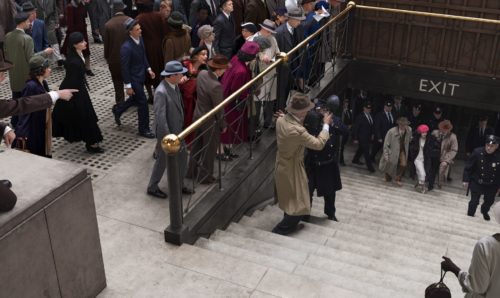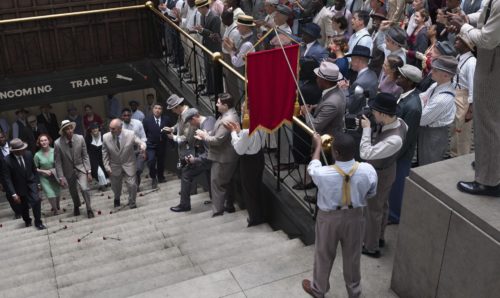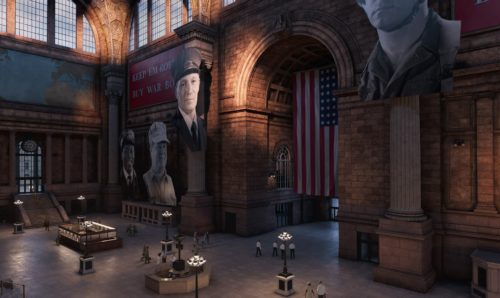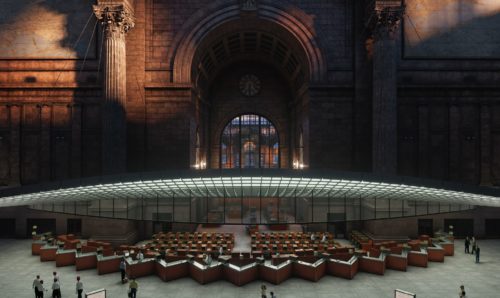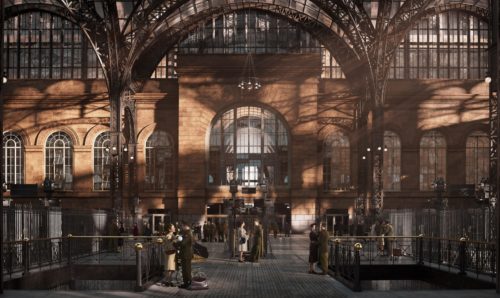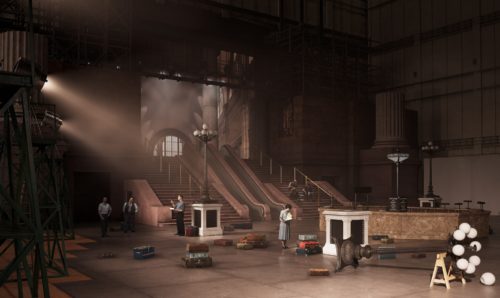Stan Douglas (Ticketed Waiting Room)
Stan Douglas (b. 1960 in Vancouver, Canada; lives and works in Vancouver)
22 April 1924 and 7 August 1934, from Penn Station’s Half Century, 2020.
Ceramic ink on glass. Nine photographic panels from Penn Station’s Half Century, installed in four niches: each niche 6′ 7 5/8” H x 22′ 2 ½” W x ½” D, Commissioned by Empire State Development in partnership with Public Art Fund for Moynihan Train Hall.
©Stan Douglas. Courtesy of the artist, Victoria Miro and David Zwirner.
Photo: Nicholas Knight, courtesy Empire State Development and Public Art Fund, NY.
Artist Stan Douglas drew on archival research to reconstruct nine remarkable but forgotten moments from the history of the original Pennsylvania Station (1910-1963). He seamlessly combined photographs of costumed performers with digitally recreated interiors of the demolished Station. The resulting images pay tribute to that grand building and to the layers of human experience that bring our civic spaces to life.
From 1910 to 1963 the original Pennsylvania Station stood one block east of Moynihan Train Hall, on the footprint of today’s Madison Square Garden. The demolition of the grand, Beaux Arts building, designed by eminent American architects McKim, Mead & White, is now considered an incomparable loss to the history of Gilded Age architecture and to the urban landscape of New York. In the Amtrak Waiting Room at Moynihan Train Hall, artist Stan Douglas’s nine photographic panels, arranged in three pairs and one triptych, reconstruct significant but little-known moments spanning the Station’s half-century lifespan, standing as vivid evocations of the city’s forgotten history. In order to recreate both the demolished building and these moments, Douglas undertook extensive archival research. Extrapolating from photographs, newspaper articles, and architectural plans, he restaged historical events by posing and photographing live performers in period costume. Douglas stitched together dozens of exposures to create each tableau, which he then set within exactingly rendered CGI (computer-generated imagery) backgrounds that faithfully reproduce the soaring ceilings and stately concourses of the original Station. Douglas selected events that chronicle the breadth of collective experience for which Penn Station served as a stage. With a cinematic quality, each scene revives history in uncanny detail, revealing this architectural landmark as a grand theater for the millions of human dramas that animate civic spaces and endow them with meaning.
Since the late 1980s, Stan Douglas has used photography, film, and theater to reconsider history and the means of its documentation, which define its shape in our collective memory. Born of exhaustive historical research, Douglas’s artworks bring new focus to overlooked events specific to a particular location. He frequently hones in on intimate, localized moments of spectacle and poignancy that speak to broader societal shifts. In restaging these events, Douglas consciously references the technologies he employs to bring them to life. In Penn Station’s Half Century, depictions of vaudeville performers, Hollywood set designs, and photo mural ad campaigns echo Douglas’s own artistic process, suggesting that photographic documentation has the potential to be a medium of fantasy as much as one of verisimilitude. Conceived specifically for the series of four architectural niches that anchor the rear wall of the Amtrak Waiting Room, the nine individual scenes are connected by multiple narrative threads and introduce subtle details that reveal themselves upon close examination. Penn Station’s Half Century is the artist’s first permanent public commission in the United States.
1 March 1914
(niche 1, panel 1)
6′ 1” H x 10′ 8 ½” W x ½” D
On March 1st and 2nd, 1914, vaudeville performers from across the Eastern Seaboard were stranded in Penn Station during an epic snowstorm that brought rail traffic to a halt. Bert Williams, the legendary singer, comedian, and first African-American to direct a motion picture, recognized the talent in the room and instigated an impromptu vaudeville show to the delight of his fellow travelers. Douglas reproduces this serendipitous moment, where acrobatics transformed the cavernous Waiting Room into a theater in-the-round, and musical numbers turned its staircase into a stage.
2 March 1914
(niche 1, panel 2)
6′ 1” H x 10′ 8 ½” W x ½” D
On March 1st and 2nd, 1914, vaudeville performers from across the Eastern Seaboard were stranded in Penn Station during an epic snowstorm that brought rail traffic to a halt. Bert Williams, the legendary singer, comedian, and first African-American to direct a motion picture, recognized the talent in the room and instigated an impromptu vaudeville show to the delight of his fellow travelers. Douglas reproduces this serendipitous moment, where acrobatics transformed the cavernous Waiting Room into a theater in-the-round, and musical numbers turned its staircase into a stage.
22 April 1924
(niche 2, panel 1)
6′ 1” H x 10′ 8 ½” W x ½” D
In 1924 Celia Cooney, famously known as the “Bobbed Hair Bandit,” became a folk hero after evading arrest following a series of brazen robberies with her husband. Alternately characterized by the press as a working-class hero or a corrupted libertine, the sensationalized Cooney was finally apprehended in Florida and returned to New York City to face charges. Douglas depicts the moment Cooney arrived at Penn Station, restaging the New York Evening Post’s report of the event: “An unruly throng jammed the station platform…Fists flew, men shouted, women screamed…[Cooney] smiled broadly to the newspaper photographers and winked as a battery of flashlight “guns” exploded.”
7 August 1934
(niche 2, panel 2)
6′ 1” H x 10′ 8 ½” W x ½” D
In 1934 Angelo Herndon, a celebrated labor organizer, gave a series of speeches in New York City during his release on bail from a Georgia prison chain gang. Herndon had been charged with insurrection for organizing a peaceful interracial demonstration of unemployed workers in Atlanta. His case, twice brought to the Supreme Court, raised consciousness nationally around the inequities of the judicial system in the American South. Douglas portrays Herndon’s arrival at Penn Station, where Communist party members and supporters gathered in the thousands to hail him as a martyr in the cause for racial justice and workers’ rights.
20 June 1930
(niche 3, panel 1)
6′ 1” H x 7′ 11/16” W x ½” D
Douglas’s third sequence of images in the series depicts three design interventions in the Station’s Waiting Room that signaled broader technological and societal changes. The scenes unfold over three decades, each shown in the early morning of June 20th, the summer solstice, as the sun pours into the Waiting Room and passengers begin to trickle into the grand space.
Penn Station’s Waiting Room boasted a novelty display of a trimotor airplane to promote a new, 48-hour coast-to-coast travel service operated by Transcontinental Air Transport in partnership with Pennsylvania Railroad and Santa Fe Railroad. The route took passengers by train to Ohio, by air to Oklahoma, by rail to New Mexico, and finally, by air to California. The ten-passenger vessel, dubbed The City of New York, was christened by pioneering aviator Amelia Earhart at its unveiling, for which it had to be taken apart and reassembled to fit into the hall. Though the line was too expensive for mass transit, it presaged the increased popularity and efficiency of air travel over the century and, consequentially, the dwindling demand for long-distance train travel.
20 June 1944
(niche 3, panel 2)
6′ 1” H x 7′ 11/16” W x ½” D
Douglas’s third sequence of images in the series depicts three design interventions in the Station’s Waiting Room that signaled broader technological and societal changes. The scenes unfold over three decades, each shown in the early morning of June 20th, the summer solstice, as the sun pours into the Waiting Room and passengers begin to trickle into the grand space.
During World War II, railroads proved vital to the war effort as the primary means for transporting goods and service people across the country. In 1943, six massive photo murals by designer Raymond Loewy were hung on the west wall of the Waiting Room to celebrate the almost 50,000 Pennsylvania Railroad employees’ service to the nation. Each depicted a representative from various professions within the Railroad: conductor, engineer, soldier, sailor, marine, and, most remarkably, “red-cap” porter, an essential occupation filled exclusively by Black men in the decades before desegregation. Ultimately, World War II would act as a catalyst for progressive changes throughout the 1950s and ‘60s in the United States, including efforts towards better labor conditions and a more racially equitable country.
20 June 1957
(niche 3, panel 3)
6′ 1” H x 7′ 11/16” W x ½” D
Douglas’s third sequence of images in the series depicts three design interventions in the Station’s Waiting Room that signaled broader technological and societal changes. The scenes unfold over three decades, each shown in the early morning of June 20th, the summer solstice, as the sun pours into the Waiting Room and passengers begin to trickle into the grand space.
By mid-century, air and automobile travel eclipsed rail as America’s primary modes of transportation, and McKim, Mead & White’s grand train station came to be regarded as outdated. In the final scene in this triptych, Douglas illustrates both the subtle ravages of time—such as the fading colors in Jules Guérin’s painted frieze of topographical landscapes, begrimed over the years by the residue of train exhaust—and a dramatic attempt to keep pace with modernity. In 1956, designer Lester C. Tichy was hired to create a futuristic Electronic Ticket Sales & Service Bureau, dubbed the “clam shell.” Though criticized for clashing with the historical architectural context of Penn Station, Tichy’s ticket counter became an important influence on celebrated modernist buildings that succeeded it, including Eero Saarinen’s swooping TWA terminal at JFK Airport. The installation of the ticket bureau proved a harbinger of the decade’s changing tastes and commercial priorities, as the McKim, Mead & White Station was demolished only six years later, in 1963.
10 November 1941
(niche 4, panel 1)
6′ 1” H x 10′ 8 ½” W x ½” D
During World War II, Penn Station was a primary arrival and departure site for deployed soldiers, and thus a site for joyous reunifications and heart-rending goodbyes. Taking on a prominent place in the American imagination, the Station exemplified the hope, gratitude, sorrow, and sacrifice experienced by so many Americans during wartime. Douglas’s tender scene, based on photos of the time, shows a final moment of affection as soldiers bid farewell to loved ones.
15 September 1944
(niche 4, panel 2)
6′ 1” H x 10′ 8 ½” W x ½” D
The last scene in Douglas’s photo series shows a soundstage from the 1945 film “The Clock” by director Vincente Minnelli. The popular film, shot entirely at the MGM studio in Culver City, CA, starred Judy Garland opposite Robert Walker, who played a soldier discovering New York City and finding love the day before his deployment to war. Douglas captures the vacant set—populated only by technicians, props, and lighting instruments—that would become the backdrop for the couple’s fortuitous meeting as well as their emotional parting. Much like Douglas’s own process, Minnelli’s film used artifice to recreate the nostalgic romance associated with the Station and its status as an iconic site in United States culture.



